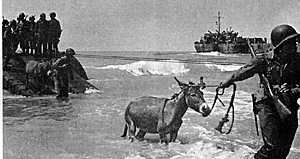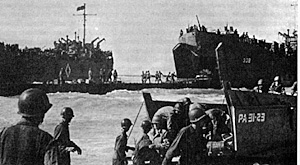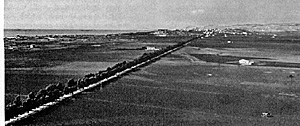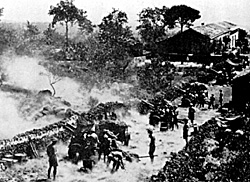 3rd Division troops and burros land at Licata.
3rd Division troops and burros land at Licata.
Sicily is a game I've wanted for a long time. A tough fight with more experienced American troops without the withering air superiority of the 1944 actions. It is a confined area (being an island) and a relatively quick campaign. I've always felt this campaign to be one that would make for a tough, fast OCS game.
Some time ago, I took over your editor's prototype on the game (he was having trouble getting it done) and went to work. His original map covered maybe half of a normal map sheet at the 5 miles per hex scale. It was obvious to give guys enough room to work up a good fight, the heretofore unused 2.5 mile OCS scale would be needed. This made for a map fitting nicely on two sheets with a goodly amount of detail for players to work with.
The next step was fleshing out the OOB. Here, again, I was ably assisted by the usual suspects (Steve Rothwell for the CW, Mauro De Vita and Andrea Galliano for the Italians). Later, during playtesting, much great info came my way from Perry Andrus and Andrew Fischer from their voluminous reading on the campaign (as well as Perry's detailed map review in the National Archives). As always, the help needed was gladly and generously offered--making for a better final game for us all.
Special Rules
As I set about working up the special rules for Sicily, I was directly confronted by three facts: 1) Our stock of OCS v2.0i rules (printed in 1995) was close to exhausted, 2) players had requested numerous times that I set about culling the existing lists of optional rules by making standard those I felt deserved such attention, and 3) Sicily itself needed some extensive rules in areas neglected in earlier OCS games (amphibious assaults and such).
 Causeway extends from bow of LST to the beach.
Causeway extends from bow of LST to the beach.
I had always explained to those asking for the consolidation (#2), that such an effort had to wait until the rule book stock was used up (#1). Everything came together with Sicily. I have detailed much of the series rules work done in another article in this issue. Sicily provided the impetus to develop the naval rules as a game-specific item. Looking at this additional "graft" onto the series rules, the limited nature of the series naval rules, and other rules acting as boilerplate in the game-specific rule books from a number of the games, I decided to consolidate.
Rather than repeating this material in every game (the latter), or in games needing the specific rules (the former), I chose to integrate the entire pile. I think the result is a set of series rules that will be more all-inclusive of all the special situations that we will be seeing in future games in the series. I think having it all in one place actually makes the entire system more compact and tighter. As always, of course, the input of many, many players and many hours spent playing were used directly to make the rules better.
Sicily the game took on three major issues right off the bat. The Allies had to get ashore and be mildly vulnerable as they did so. The Allied air force doctrinally failed to support the landings. Lastly, the Axis needed reasons to avoid falling back into the Messina peninsula right away (they needed incentives to hold more of the island, especially Palermo).
The Allied landing and subsequent vulnerability issue was one of developing the landing rules (for the series) and tweaking the availability of landing craft. With the latter, I had to constrain the Allied ability to get troops to the beach right away. The original game forced the Allies to take a trace-capable port on the first turn (or starve). As that put far too much of a premium on the handful of such ports, the ability to use LSTs as a supply source (for trace) came about. The limited number of LSTs (combined with the inability to flip them back into boats after being deployed) meant that players had to make some serious decisions on where and when to use them. Keeping a few undeployed allowed for more lift capability and a "threat-in-being" for the Axis to worry about (i.e. potential later landings). The choices the Allied player makes will trade-off immediate safety for later potential and make for some interesting dilemmas for him to deal with.
Air Forces
The Allied air forces were particularly numerous in this battle and also managed to drop the ball to an extensive degree. Since the air commanders saw their goal as strategic interdiction, once the landings occurred, the major air effort shifted to the boot of Italy (much to the chagrin of the ground-pounders coming in contact with Axis counterattacks and the supposedly dead Luftwaffe). This is not to say that the air chiefs claim adequate support for the ground forces; they do, but from my reading it seems clear that the operations on Sicily were low on the list of things they wanted to do. To cover this, I allowed only a limited number of air barrage attacks per turn (based on a die roll). Other limitations came and went during testing.
In the end, suffice it to say that of the enormous number of Allied aircraft involved, only a few can directly help the player's ground units. This doctrinal infighting was not resolved until the battles in France in 1944. The doctrine that caused this failure has its roots in the opposite failure (too much ground support, not enough central control) in Tunisia. This pendulum won't find a happy medium until the great Allied air support developed after the D-Day landings (and some could argue that this happy result only occurred because of the super-abundance of Allied air power at that time).
 The Gela Plain, where US firepower stopped the Hermann Goering Division's counterattack against the beachhead.
The Gela Plain, where US firepower stopped the Hermann Goering Division's counterattack against the beachhead.
Getting players to play a game has always been a bug-a-boo. Before I started design work publicly, I could never have imagined the stunts some players will go to so as to "win" a game. "Winning" here means in terms of victory points; the fun measurement by both sides (true indicator of "winning") goes out the window with these guys. It seems that I need to drag some guys, kicking and screaming, to get them to actually play the game. This was certainly what occurred in the testing of Hube's Pocket. I found very early on that almost every German player would instantly tell Hitler where he could shove it, followed by a rapid retreat to the west. No amount of cajoling could get these guys to stand and fight (leading me to wonder why they bothered to sit down to the game if they had no intention of actually playing it). This led to the vicious sudden death victory conditions many of you have struggled with in that game--the Germans must make the Russians pay for every inch of that map with blood at great cost to themselves.
In Sicily's case, the natural Axis reaction to the landing is to haul-off to the thin, mountainous stretch of land to the south of Messina. It didn't take long in testing for this to take on the "run like hell" tactic similar to the early versions of Hube's. My first inclination was to make Palermo worth a ton of VPs to force the Axis to try to hang on to it. Checking with Mauro to see if his reading of the official histories showed that the Axis high command placed any particular importance on Palermo, I found that they didn't. Moving beyond the VP importance which did not seem reasonable, I checked into the establishment of the ferry points to the toe of Italy. The game allowed these points to operate from the very beginning of the campaign. Digging deeper, it became apparent that this was not the case and that these did not begin operations until much later (upon the arrival of a German motor flotilla group).
This immediately solved the "run away" business. Prior to that date, the Axis had to rely on a shipping capacity to get units and supplies to the island. The run-away defense requires that all Axis shipping be directed into Messina (a big port, mind you). The problem is, once the player dumps the rest of the map (and the other ports), Messina will then become ground zero for air operations and naval bombardments. Until the ferries begin operating, there is no way the Axis player will want to put all his eggs in one basket. To do so early would be to commit logistical suicide. (Things are pretty tight as it is!)
The first effort the Axis has to do in the game (after telling the Allied player to hurry the hell up with his landings) is to counterattack the beaches. The German units on the island range from the excellent 15 PG Division to the mediocre Hermann Goring Panzer Division. These units are represented in their Kampfgruppen structure. Early versions of the game had them organized by division instead which resulted in a mad rush to get their locations under control before the first Axis Supply Phase (to erase the confused locations).
To keep this ahistorical dance from being the first thing the Axis player had to do, I put all these units into their KGs and used the KG as the base for supply concerns. This makes them cost a bit more for fuel when consolidated (rare), but keeps the organization under control when it matters most. Slicing into the initial Allied landings is a lot of fun for the Axis player (and should make the Allied player sweat a little). Early games used the two-step brigade/regiment size rules from DAK, but I found in play that this made the Allied beachheads just too resilient to counterattack (I found that out the hard way, mind you, when I launched a panzer death-ride into one of Rod Miller's beaches. I think my lead tanks could see the ocean just before they died, but reports vary).
 Guns of the 91st Field Regiment RA firing near Mt. Etna.
Guns of the 91st Field Regiment RA firing near Mt. Etna.
I also heard reports of multiple Allied divisions being destroyed in a massive Axis counterattack in one game. This was with the earlier (and stronger) versions of both the HG Pz Division and Luftwaffe under the most able of players. I have not seen this happen since the revisions and (as Rod likes to tell me) "Yes, that happened, but what people forget is that the Germans destroyed their own force doing it." C'est la guerre.
No Italy
One decision I made early on in this design was to rule out any early landing in Italy proper (or more specifically, the Toe of the Boot). I realize this is an option presented in a competing game on the same subject, but I feel it is a totally ahistorical ability that only serves to cheapen the design of a Sicily game. Here is why: First, planning for Husky began months before the actual landings; deciding on the fly to change to an early leap onto Italy proper (while discussed...and rejected) could not have been made by the time the player is presented with the game situation. The Joint Chiefs were hard-pressed to fully agree on Husky, let alone something more adventurous. Second, the historical situation from the very first turn would be radically different (how would be a matter of extreme speculation). That would mean that reinforcement units and timing would have nothing to do with the historical situation.
Any game tied to the historical reinforcements with this changed situation would be completely meaningless as an examination of this history. (This can be used as an indictment of all wargames, but most games at least keep the same subject along with the reinforcement slate--one does not game the invasion of Poland by invading France.) Lastly, to include such a flight of fancy would entail mapping and supplying with units a great part of southern Italy (it being ridiculous to state that the Allies would be content to take over a small bridgehead on the very Toe of the Boot. No thanks, we don't do fantasy games.
So, how does the Axis player "win" Sicily? Exceptional Axis counterattack strategy combined with lackluster Allied play can throw the invaders back into the sea (a very rare event, though it did come close to happening in testing). Failing that, the Axis must trade island for time. In the bitter end, the Axis will win if the player can extricate numerous German troop units as well as hold the island longer than it was held historically. That is a trade-off the player must make--he can pull units off early (so as to get credit for them), but must still keep the island longer than the historical Axis did to get a win. Get the German units destroyed in place while holding till the game's drop dead turn, you'll still lose. The Axis must balance these two.
For the Allies, they must pull off a rapid coup to take the island and kill off as many German units as possible in the process. You'll note that the Italian units here do not matter for victory. Mussolini had decided the island was lost (and the troops written off) the moment the invasion occurred. The Italian troops felt likewise and many surrendered without a fight (as usual a few did well, but they were in the minority here, especially). Friction between the two Axis nations came to a head as German troops took over the defense of both Sicily and the Boot. The Italians ceased to be part of the war. I treated them as a side-affair in this campaign.
I'm very proud of how Sicily has evolved in the last year or so of playtesting. The usual hard-pressed crew of testers have given greatly of their time, talent and experience to make this game a real treat. I hope you'll agree.
Back to Table of Contents -- Operations #37
Back to Operations List of Issues
Back to MagWeb Master List of Magazines
© Copyright 2000 by The Gamers.
This article appears in MagWeb (Magazine Web) on the Internet World Wide Web.
Other military history articles and gaming articles are available at http://www.magweb.com